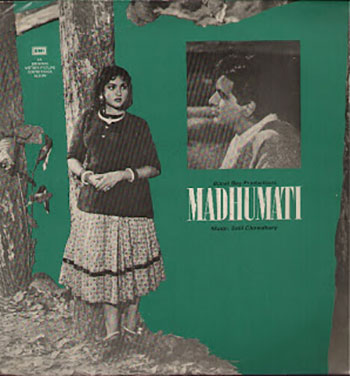 Madhumati – Salil Chowdhury
Madhumati – Salil Chowdhury
Songs in Hindi films have a unique role. They have to carry the narrative when you are watching the movie and they also have to stand tall as an independent entity when you are listening to them from your music system. Very few albums manage to do justice to both but what ‘Madhumati’ has achieved is something way beyond. The movie and its music have become beautifully amalgamated and today it’s impossible to separate the two. It takes a giant to achieve this and that’s what Salil Chowdhury was. Of course, he was helped by two other giants Bimal Roy (director) and Shailendra (lyricist).
Salilda, as he was lovingly called, came from the hills and Madhumati was set in the hills. The two became a perfect match for each other and the resulting music beautifully carries the sweet smell of the region. The LP record kicks off with the goatherd’s Urrrrrrrr of Suhaana Safar, a classic Mukesh track that is popular even today, amongst many. This is followed by the folksy and sweet Ghadi Ghadi (Lata Mangeshkar) and then comes the Nepali flavoured Kancha Le (Asha Bhosle, Sabita Chowdhury, Ghulam Mohd. & Chorus).
What comes next is one of the greatest duets in the history of film music. A song of love which is as beautiful as love itself. Dil Tadap Tadap Ke sung with complete earnestness by Lata and Mukesh and inspired by a Polish folk song, stands the test of time as one the best musical symbol of love from the Indian film industry (and I’m not even getting into the sublime visualization of the song). Side One ends with the cyclical and almost trippy Chadh Gayo Papi Bicchua (Lata, Manna Dey & Chorus).
Side Two opens up with the haunting and magical Aaja Re Pardesi, made doubly haunting and magical by Lata’s singing and Shailendra’s lyrics. The song embodies the line ‘Bhed Yeh Gehra, Baat Zara Si’. This is followed by the peppy Jungle Mein Mor Nacha (Mohd. Rafi).
Then comes one of the sweetest songs ever composed Julmi Sang Aankh Ladi. Based on a Kumaaoni folk song, Lata is at her melodious best here. In fact, ‘Madhumati’ is a sparkling showcase of Lata’s abilities as a singer. The next two tracks are the tribal nuanced Tan Jale Mann Jalta Rahe (Dwijen Mukherjee & Chorus) and the Mehfil flavoured Hum Hal-E-Dil (Mubarak Begum).
The album ends with the heartbreakingly sad Toote Hue Khwaabon Ne rendered brilliantly by Mohd. Rafi. If you listen to it carefully enough you will hear the longing lover’s teardrops fall.
Hindi film music has produced many stalwarts, but Salil Chowdhury for me, shines the brightest amongst them all. Ranging from my childhood nostalgia to the experimental genius of his musical mind, there are many reasons to it. But if I was to simplify things, it’s the element of an intelligent and beautiful surprise in his compositions that tickles me. Whether it’s a flute introduction or a violin interlude or choir-like vocal or playing with the scales, listening to Salilda’s music always gives me a reason to smile and say, ‘Oh that’s such a lovely fresh approach’. Even if I am listening to that track for the nth time.
Year: 1958
Genre: Hindi Film Music
Label: HMV
Rating: *****
Reviewed by Meraj Hasan
Meraj Hasan is a Mumbai based communication professional (and an amateur poet/musician) with a passion for listening to music the vinyl way. His 25 year old Technics turntable along with a humble collection of LPs across genres like Classic rock, Classical, Blues and Jazz (amongst others) are his prized possessions.
He can be reached at +91 9833410791 or email: meraj.hasan@gmail.com .
